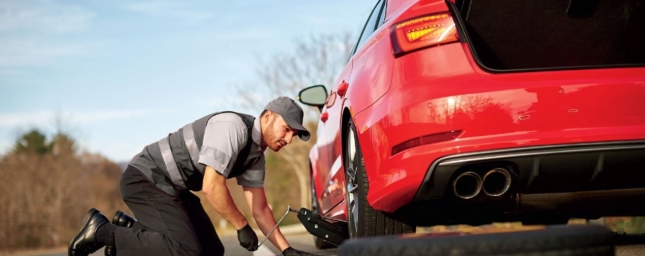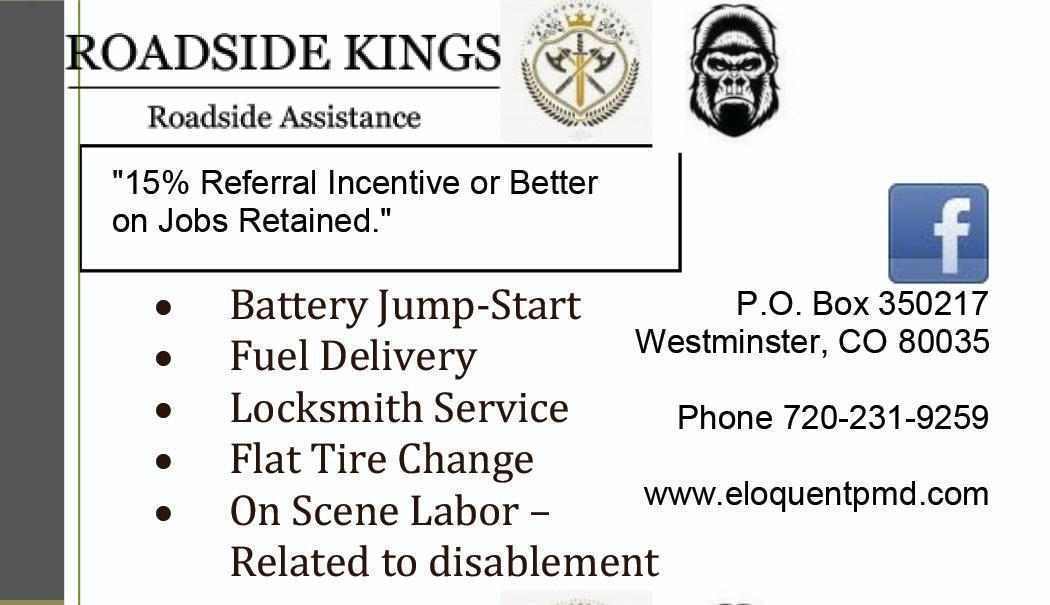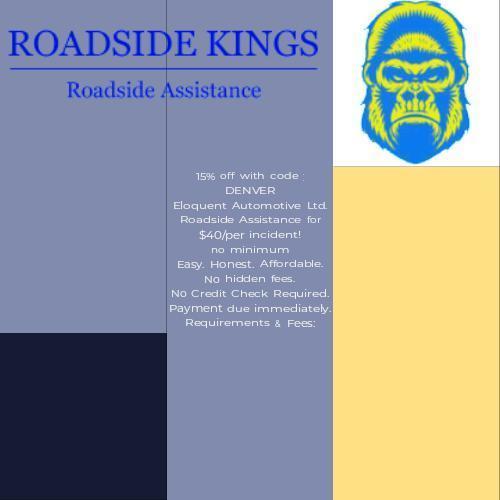

Roadside Kings
As an alternative branch to Eloquent Property Management and Design are basic roadside assistance contracting division “Roadside Kings” this part of the organization performs the following services 24 hours everyday.
- Battery Jump-Start
- Fuel Delivery
- Locksmith Service
- Flat Tire Change
- On Scene Labor – Related to disablement
We cover the following zip codes within a 45 minute time frame; the company resides primarily in the Westminster, Broomfield, Northglenn, Federal Heights, and Thornton general vicinity.
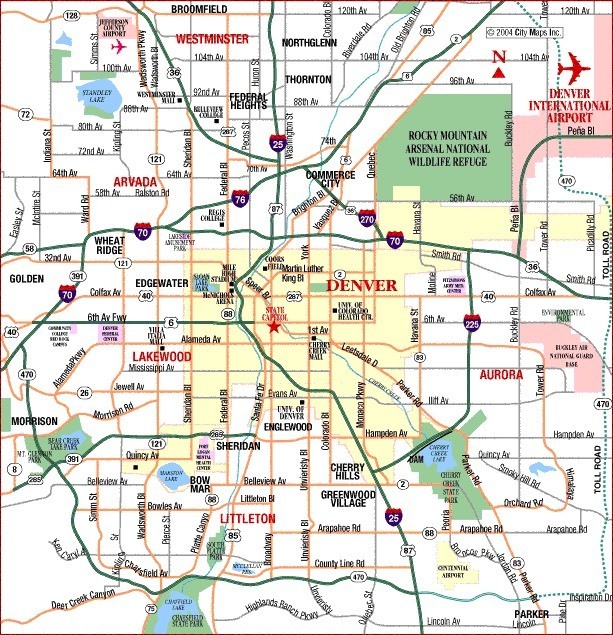
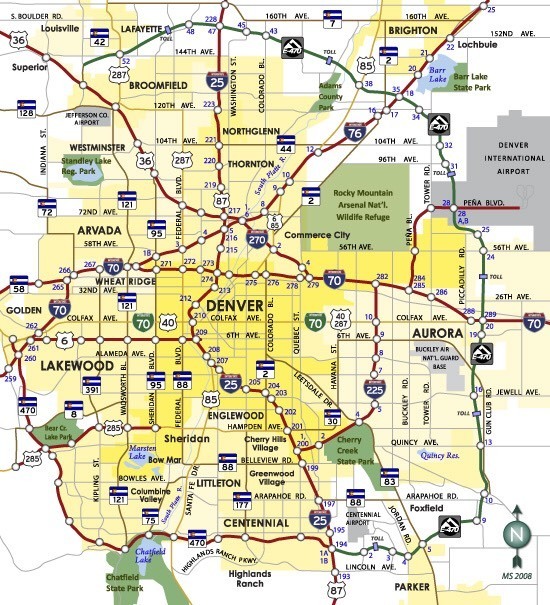
Denver-Aurora-Lakewood Metro Area, Colorado:
| 80002 (Arvada) 80003 (Arvada) 80004 (Arvada) 80005 (Arvada) 80007 (Arvada) 80010 (Aurora) 80011 (Aurora) 80012 (Aurora) 80013 (Aurora) 80014 (Aurora) 80015 (Centennial) 80016 (Aurora) 80017 (Aurora) 80018 (Aurora) 80019 (Aurora) 80020 (Broomfield) 80021 (Westminster) 80022 (Commerce City) 80023 (Broomfield) 80024 (Derby) 80030 (Westminster) 80031 (Westminster) 80033 (Wheat Ridge) 80045 (Aurora) 80101 (Agate) 80102 (Bennett) 80103 (Byers) 80104 (Castle Rock) 80105 (Deer Trail) 80107 (Elizabeth) 80108 (Castle Pines North) 80109 (Castle Rock) 80110 (Englewood) 80111 (Cherry Creek) 80112 (Centennial) 80113 (Englewood) 80116 (Franktown) 80117 (Kiowa) 80118 (Larkspur) 80120 (Littleton) 80121 (Centennial) 80122 (Centennial) 80123 (Denver) 80124 (Lone Tree) |
80125 (Roxborough Park) 80126 (Highlands Ranch) 80127 (Dakota Ridge) 80128 (Ken Caryl) 80129 (Highlands Ranch) 80130 (Highlands Ranch) 80131 (Louviers) 80134 (Parker) 80135 (Sedalia) 80136 (Strasburg) 80137 (Watkins) 80138 (Parker) 80202 (Denver) 80203 (Denver) 80204 (Denver) 80205 (Denver) 80206 (Denver) 80207 (Denver) 80209 (Denver) 80210 (Denver) 80211 (Denver) 80212 (Denver) 80214 (Lakewood) 80215 (Lakewood) 80216 (Denver) 80218 (Denver) 80219 (Denver) 80220 (Denver) 80221 (Sherrelwood) 80222 (Denver) 80223 (Denver) 80224 (Denver) 80226 (Lakewood) 80227 (Lakewood) 80228 (Lakewood) 80229 (Thornton) 80230 (Denver) 80231 (Denver) 80232 (Lakewood) 80233 (Northglenn) 80234 (Westminster) 80235 (Denver) 80236 (Denver) 80237 (Denver) |
80238 (Denver) 80239 (Denver) 80241 (Thornton) 80246 (Denver) 80247 (Denver) 80249 (Denver) 80260 (Thornton) 80264 (Denver) 80290 (Denver) 80293 (Denver) 80294 (Denver) 80401 (Golden) 80403 (Fairmount) 80419 (Jefferson County) 80420 (Alma) 80421 (Bailey) 80422 (Black Hawk) 80425 (Buffalo Creek) 80427 (Central City) 80432 (Como) 80433 (Conifer) 80436 (Downieville-Lawson-Dumont) 80438 (Empire) 80439 (Evergreen) 80440 (Fairplay) 80444 (Georgetown) 80448 (Grant) 80449 (Hartsel) 80452 (Idaho Springs) 80453 (Idledale) 80454 (Indian Hills) 80456 (Jefferson) 80457 (Kittredge) 80465 (Dakota Ridge) 80470 (Pine) 80475 (Shawnee) 80476 (Silver Plume) 80601 (Brighton) 80602 (Thornton) 80640 (Commerce City) 80820 (Guffey) 80827 (Lake George) 80830 (Matheson) 80835 (Simla) |
Roadside Kings
P.O. Box 350217
Westminster, CO 80035
(303) 641-4388
![]()
We need need new service techs and dispatch representatives who would like to work for our company. Please feel free to contact us to be further advised on the application process.
I.S.A.E. Defensive Driving Articles of Interest
Each state has a legislature where new laws are passed, and old laws are revised during the legislative session of their General Assembly.
Some valuable information that leads to better decision-making in the future also includes realizing how your actions behind the wheel may be affecting your life in negative ways, and knowledge being power.
There are Statutory Cities vs. Home Rule Cities.
In other words, home rule cities, municipalities, and/or counties have more flexibility regarding making their own laws.
In these states, a city or county must obtain permission from the state legislature if it wishes to pass a law or ordinance which is not specifically permitted under existing state legislation. Therefore, penalties follow state statute, or state law.
To encourage you to modify your behavior when you are behind the wheel of your vehicle. There are the following principles.
- The meaning of C2
- The difference between EQ and IQ
- The difference between Reacting and Responding
- The ABC's of Driving
- Distracted Driving and Other Distractions
- How Influences + Attitude affects my Actions
- Seat Belts
- Drinking and Driving
- Drugged and Driving
You may make a right turn on red if:
- they come to a complete stop
- they yield to pedestrians
- they yield to other traffic legally using the intersection
- no signs are posted otherwise; for example "no turn on red"
The seating capacity is based on the number of WORKING seat belts for the vehicle in question.
You must signal continuously for 100 feet prior to turn or lane change. On four lane highways where the speed limit is more than 40 m.p.h., you must signal for 200 feet.
- a) No driver shall make a U-turn if:
A traffic control sign is in place prohibiting U-turns or left turns.
Remember, Upon any curve or upon approach to or near the crest of a grade where the turning vehicle cannot be seen for 300 feet by the driver of any other vehicle that might approach from the other direction; Unless such movement can be made in safety.
In most states, you may pass another vehicle on the right side on a one-way street or on a roadway with two or more lanes of traffic in each direction, but it is illegal to speed.
If you are involved in a motor vehicle crash and there are no injuries, the vehicles must be moved from traffic.
In some states, refusal to submit to a BAC test can result in fines and, or jail time.
You cannot accumulate more than 6 points on your driving record without having my license suspended.
Some laws target hand-held devices only, while other laws affect both hand-held and hands-free devices.
It is a well-known fact that distracted driving results in thousands of fatalities each year. Although various types of objects and other in-vehicle activities are capable of distracting drivers, cell phones have proven especially troublesome.
Remember to hang up and drive.
Driving requires 100 percent of your attention, 100 percent of the time.
Most states require that a fastened safety belt must be worn in all motor vehicles,that were factory equipped with a safety belt system, while in operation on public roads.
Remember that your attitude drives your behavior, and your behavior drives your choices. A bad attitude is like a immobile vehicle. C2= Choices & Consequences – you are free to choose, but you are not free of the consequence.
There are multiple conditions which influence your driving. For example, light, weather, road, traffic, vehicle, and the driver.
Some distractions are when you are behind the wheel of your vehicle, as well as other non-driving distractions that can quickly bring harm. Multitasking, or switch tasking, stopping distances, tailgating, cell phones, texting and wearing earbuds.
When You Attempt to Multitask, You Do Things Poorly And It Actually Takes Longer.
Three Factors When Considering Stopping Distances perception, reaction, and braking.
- "Perception Distance", or "thinking distance" is the distance your vehicle travels from the time your eyes see a hazard until your brain recognizes it. For an alert driver, this is about second.
- Reaction Distance is the distance you traveled from the time your brain tells your foot to move from the accelerator until your foot is actually pushing the brake pedal.
- Braking Distance is the distance the car travels from when you first apply the brakes, to where the car stops.
This is why you must keep your vehicle in excellent working condition.
- Tires – a) type, b) tread depth*, c) compound (*replace at 1/8 inch tread depth or less to help avoid hydroplaning)
- Vehicle weight
- Condition of brakes – a) rotors, b) brake pads, c) brake shoes
- Anti-lock braking system (ABS) – Leaking brake lines
- Shocks, struts, and springs
- Road type – a) concrete, b) asphalt, c) dirt, d) gravel
- Roadway grade (slope)
- Weather conditions
- 10 Things to check on your vehicle
- Oil, change regularly and keep it full
- Tire pressure
- Brakes, check periodically
- Power steering fluid
- Wheel alignment
- Winter antifreeze, summer coolant
- Tire tread depth
- Air filter
- Transmission fluid, change regularly
- All lights
There are two types of drivers
- Those who have been in an accident
- Those who will be in an accident
Driving Requires
- 100% Of Your Attention
- 100% Of The Time
Anger is defined as:
- a strong feeling of being upset or annoyed because of something wrong or bad.
- a strong feeling of annoyance, displeasure, or hostility.
- the feeling that makes someone want to hurt other people, to shout, etc.
Violence is defined as:
- exertion of physical force so as to injure or abuse.
- intense, turbulent, or furious and often destructive action or force.
- intense feeling or expression.
Road Rage is defined as:
- a motorist's uncontrolled anger that is usually provoked by another motorist's irritating act and is expressed in aggressive or violent behavior.
- anger and aggressive behavior by a driver who is upset by how another person is driving.
EQ=
- React
- Over React
IQ=
- Respond
- Acknowledge
Managing Our Emotions Behind the Wheel entails the fact that People do not automatically become angry or violent. Some people escalate very quickly, and others escalate over a long period of time. By identifying which stage of anger or violence we are in, we can take active steps in controlling our behavior. Keep in mind, you cannot control the behavior of others, but you can help them redirect.
Stage 1 – Tension Building
Many different situations may cause stress or irritation. We refer to these as "situational triggers." Examples of situational triggers are
- having a bad day
- financial stress, e.g., lots of bills
- drinking and/or drugging
- a disturbing phone call
- feeling that you are being nagged
- an argument with a friend
If we don't take active steps to relieve the stress that can come from the triggers, we will enter the tension building stage. At this stage we usually feel a little edgy, out of balance, or ticked off.
Stage 2 – Verbal Escalation
This stage can happen when we allow our tension to build to the point where we are angry enough to vent our feelings to anyone who gets in the way. This could be someone who confronts you about something, or someone who is looking at you wrong, or perhaps someone who does one more thing (big or small) that irritates you. In this state, we are looking for a way to vent. Often, we use an action by a girlfriend/boyfriend, family member, or sometimes a total stranger as an excuse to vent without identifying what is really bothering us.
Stage 3 – Physical Escalation
This is the explosion point. Once a person reaches this level, it is very difficult to help them redirect.
Recognizing our physical triggers will help us to redirect before an explosion occurs.
If we don't redirect, we may begin to destroy property, such as punching walls, throwing things, etc., intimidating others, such as glaring, raising fists, targeting, etc., become physical towards others, such as shoving, pushing, hitting, or even using weapons, such as guns, knives, vehicles, or anything readily available
Influences
Influence + Attitude = Actions
- The power to change or affect someone or something
- The power to cause changes without directly forcing them to happen
- A person or thing that affects someone or something in an important way
If you do what you have always done, you will get what you have always gotten. A seat belt, is nothing more than a safety device designed to secure occupants of a vehicle against harmful movement that may result during a collision or a sudden stop. It is "To Wear Or Not To Wear Your Seat Belt" that will or will not cause the following.
The Car's Collision
- The first crash "causes" the vehicle to buckle and bend as it hits something and comes to an abrupt stop. This occurs in approximately 1/10 of a second.
The Human Collision
- The second crash "occurs" when the passengers hit some part of the vehicle's interior.
The Internal Collision
- After the passengers come to a complete stop, their internal organs are still in motion.
Stage 4 – Opportunity for Change
This stage can only take place after everyone calms down and it is a choice. If you want to prevent the same cycle from happening again, you may want to consider the following questions:
- What was really wrong?
- Where you stressed that day?
- Did you need to be left alone?
- What could you have done to relieve your stress?
- Do you need more serious help?
The following is a list of items identified as contributing to aggressive driving and road rage.
- running late and having too many obligations
- the anonymity provided by a closed vehicle
- disregard for others and the law
- chronic anger
- traffic jams caused by construction zones
- increased levels of interpersonal stress
- two-family careers
- loud thumping music on the car radio while driving
Engaging angry drivers will only make the situation worse, possibly even dangerous for yourself and others on the road.
- if you travel slowly, pull over to allow traffic to pass
- avoid eye contact with an aggressive driver
- keep away from erratic drivers
- don't challenge other drivers by speeding up to hold your own
- ignore gestures and DO NOT return them
- DO NOT drive angry
Operation of Vehicle Approached by Emergency Vehicle
When an emergency vehicle behind you is operating with lights and sirens, it is your obligation to yield the right-of-way where possible.
Motorcycles and Pedestrian Laws
- It is important to remember that every person operating a motorcycle shall be granted all of the rights and shall be subject to all of the duties applicable to the driver of any other vehicle.
- It is important to remember that you must yield to a pedestrian, even one who is violating the right-of-way laws.
Operation of Bicycles and Other Human-Powered Vehicles
- Every person riding a bicycle or electrical assisted bicycle shall have all of the rights and duties applicable to the driver of any other vehicle under state statute.
Stopped Or Stopping School Buses
- Always slow down for school buses that are slowing down or have stopped. Yellow flashing lights means that the bus is about to stop and red flashing lights means that the bus has already stopped.
Be aware that large semi-trucks have four (4) blind spots:
- directly in front of the cab
- directly behind the rear bumper
- on the left side of the cargo trailer, and
- on the right side of the cargo trailer
So stay out of them!
The larger the truck, the larger the driver's blind spot, and if you cannot see their mirrors, they cannot see you. Also, one of the more important things to remember about semi-trucks is that they need significantly greater stopping distance than a regular sized car or pickup truck.
Railroad Crossings
- Expect a train anytime when approaching a railroad crossing. Remember, Never stop on the tracks or attempt to drive around lowered gates.
Drinking / Drugging /& Fatigued Driving
Refusing A Breath Test Is A Violation Of The Law. All states have 'implied consent laws' that come into effect when you have a BAC test and it is either over .08 or you refuse to take a chemical test when requested by law enforcement.
Implied consent laws include:
- Producing a drivers license and proof of insurance when asked
- Consenting to breath, blood or urine tests to determine your BAC, if requested
- Performing field sobriety tests if requested
The reasoning that supports implied consent law is that driving is a privilege, not a right, and law enforcement must determine if you are a danger to the public if it is suspected you are driving while under the influence of alcohol or illegal drugs.
Drunk driving is the act of operating a motor vehicle with the operator's ability to do so impaired as a result of alcohol consumption, or with a blood alcohol level (BAL) in excess of the legal limit.
After alcohol, marijuana is the drug most often found in the blood of drivers involved in crashes.
Those involved in vehicle crashes with THC in their blood, particularly at higher levels, are three to seven times more likely to be responsible for the incident than drivers who had not used drugs or alcohol.
Fatigued Driving
Fatigued driving has become a major problem in the U.S. today. Researchers estimate that more than 50 million Americans suffer from over 80 different sleep disorders, and another 20 to 30 million suffer from intermittent sleep problems annually.
